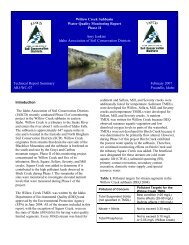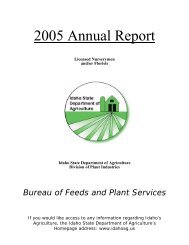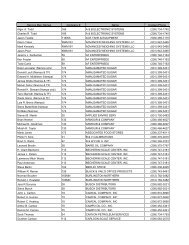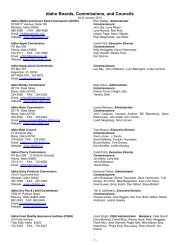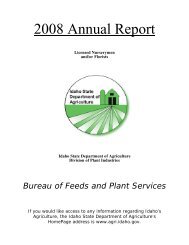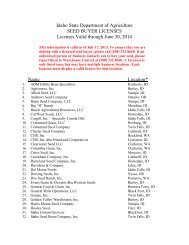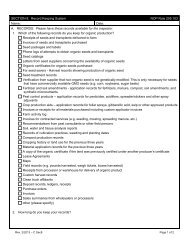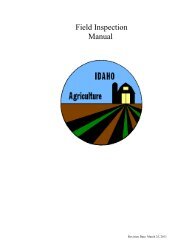2008 Statewide Strategic Plan for Eurasian Watermilfoil in Idaho
2008 Statewide Strategic Plan for Eurasian Watermilfoil in Idaho
2008 Statewide Strategic Plan for Eurasian Watermilfoil in Idaho
Create successful ePaper yourself
Turn your PDF publications into a flip-book with our unique Google optimized e-Paper software.
Some or many of these techniques are used ma<strong>in</strong>ly <strong>for</strong> research. Few of them are used <strong>for</strong><br />
operational control programs. In decid<strong>in</strong>g which survey techniques to use <strong>for</strong> a control program,<br />
consideration should be given to the costs and practicality of different approaches.<br />
Consider<strong>in</strong>g the difficulty that may be encountered <strong>in</strong> dist<strong>in</strong>guish<strong>in</strong>g between the non-native<br />
<strong>Eurasian</strong> and various native watermilfoils, it is important to remember to collect voucher specimens<br />
(Haynes 1984, Hellquist 1993). Difficulties of this sort <strong>in</strong> southern British Columbia were<br />
described by Newroth (1993). In addition, identification of watermilfoils can be made difficult by<br />
the occurrence of hybrids between Myriophyllum spicatum and M. sibiricum (Moody and Les<br />
2002). It is recommended that people work<strong>in</strong>g on the identification of watermilfoils <strong>in</strong> <strong>Idaho</strong><br />
cooperate with the L.C. Erickson Weed Diagnostic and Invasive <strong>Plan</strong>t Mapp<strong>in</strong>g Laboratory at the<br />
University of <strong>Idaho</strong> and other sources of technical assistance.<br />
ISDA Response: ISDA is aware of the issues related to the potential of milfoil misidentification as<br />
this genus is notorious <strong>for</strong> these types of problems. ISDA will seek technical assistance as<br />
necessary and will encourage local cooperators to conduct detailed surveys <strong>in</strong> their areas and<br />
collect voucher specimens <strong>for</strong> as many populations as are feasible.<br />
Recommendation 7.2: Operational surveys<br />
Assessment of EWM be<strong>for</strong>e and after control may be done by staff of the ISDA or a Cooperative<br />
Weed Management Association or a county or another unit of government. If contractors are used<br />
to conduct the surveys, the ideal situation would be to separate the contracts <strong>for</strong> survey<strong>in</strong>g and<br />
control operations. Alternatively, such an assessment may be done by a contractor, who may<br />
also conduct the EWM control operations. When funds from the ISDA are used to cover at least a<br />
portion of the costs of control, some ef<strong>for</strong>t by staff of the ISDA or other unit of government as<br />
described above is needed to verify the reliability of the assessment done by the contractor.<br />
In Florida, the monitor<strong>in</strong>g of plant populations is greatly facilitated by GIS/GPS mapp<strong>in</strong>g programs<br />
and done annually by 16 FDEP biologists <strong>in</strong> 450 lakes <strong>in</strong> Florida cover<strong>in</strong>g an area of 1.3 million<br />
acres (http://www.dep.state.fl.us/lands/<strong>in</strong>vaspec). The FDEP biologists utilize GPS to outl<strong>in</strong>e weed<br />
beds, develop maps and compile acreage estimates quickly with this method. Other states<br />
<strong>in</strong>clud<strong>in</strong>g Cali<strong>for</strong>nia and M<strong>in</strong>nesota and others regularly survey state water resources. Monitor<strong>in</strong>g<br />
of herbicide treated areas can be as sophisticated (and costly) or as simple (cheap) as a visual<br />
comparative observation.<br />
As noted above, there are many ways to determ<strong>in</strong>e treatment effectiveness. Post-treatment<br />
sampl<strong>in</strong>g <strong>for</strong> contact herbicides 2,4-D and triclopyr can be done 4-6 weeks post-treatment. Posttreatment<br />
evaluation <strong>for</strong> fluridone is best accomplished <strong>in</strong> late fall, 10-12 weeks post-treatment.<br />
Regardless of the survey methods chosen, it is imperative that a separate organization from the<br />
applicator does the pre- and post-treatment surveys to avoid real or perceived conflict of <strong>in</strong>terest.<br />
ISDA Response: The ISDA Aquatic <strong>Plan</strong>ts Program Manager will make contact with other states<br />
where large scale submersed aquatic vegetation control programs are ongo<strong>in</strong>g. Through these<br />
professional contacts and other technical assistance, the Program Manager will summarize<br />
available pre and post-treatment survey methods and draft general recommendations <strong>for</strong><br />
evaluat<strong>in</strong>g control programs <strong>in</strong> cold water systems. This <strong>in</strong><strong>for</strong>mation will be provided to local<br />
cooperators <strong>for</strong> <strong>in</strong><strong>for</strong>mational purposes, but it should be noted that the EWM programs are locallymanaged<br />
and the responsibility of project efficacy rests with the local cooperator.<br />
68



